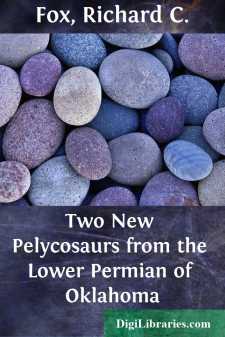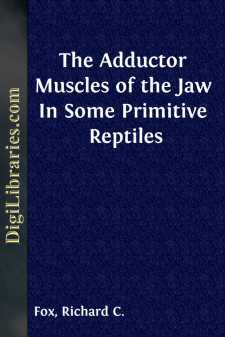Categories
- Antiques & Collectibles 13
- Architecture 36
- Art 48
- Bibles 22
- Biography & Autobiography 813
- Body, Mind & Spirit 141
- Business & Economics 28
- Children's Books 12
- Children's Fiction 9
- Computers 4
- Cooking 94
- Crafts & Hobbies 4
- Drama 346
- Education 46
- Family & Relationships 57
- Fiction 11826
- Games 19
- Gardening 17
- Health & Fitness 34
- History 1377
- House & Home 1
- Humor 147
- Juvenile Fiction 1873
- Juvenile Nonfiction 202
- Language Arts & Disciplines 88
- Law 16
- Literary Collections 686
- Literary Criticism 179
- Mathematics 13
- Medical 41
- Music 40
- Nature 179
- Non-Classifiable 1768
- Performing Arts 7
- Periodicals 1453
- Philosophy 64
- Photography 2
- Poetry 896
- Political Science 203
- Psychology 42
- Reference 154
- Religion 513
- Science 126
- Self-Help 83
- Social Science 81
- Sports & Recreation 34
- Study Aids 3
- Technology & Engineering 59
- Transportation 23
- Travel 463
- True Crime 29
Two New Pelycosaurs from the Lower Permian of Oklahoma
by: Richard C. Fox
Categories:
Description:
Excerpt
In the course of examining material from fissure deposits of early Permian age collected from a limestone quarry near Fort Sill, Oklahoma, the author recovered several tooth-bearing fragments of small pelycosaurs. The fragments were examined, compared with descriptions of known kinds appearing in the literature, and determined to be new genera within the Nitosauridae (Edaphosauria) and Sphenacodontidae (Sphenacodontia).
Appreciation is expressed to Prof. Theodore H. Eaton, Jr., for permission to examine the collections of the University of Kansas from Fort Sill, and for the financial assistance furnished by his National Science Foundation grant (NSF-G8624). I am grateful both to Prof. Eaton and Mr. Dale L. Hoyt for their suggestions regarding this manuscript. The accompanying figures have been drawn by the author.
Family NITOSAURIDAE
Delorhynchus priscus new genus and new species
(delos, Gr., evident; rhynchos, Gr., neuter, nostril; priscus, L., ancient. Delorhynchus is masculine because of the ending that it acquires when transliterated into Latin.)
Type specimen.—Fragmentary left maxilla, bearing four teeth, KU 11117.
Referred specimens.—Fragmentary right maxilla having four teeth, KU 11118; fragmentary left maxilla having four teeth, the most posterior of which has been broken, KU 11119.
Horizon and locality.—A fissure deposit in the Arbuckle limestone at the Dolese Brothers Limestone Quarry, approximately six miles north of Fort Sill, in sec. 31, T. 4 N, R. 11 W, Comanche County, Oklahoma. These sediments are of early Permian age, possibly equivalent to the Arroyo formation, Lower Clear Fork Group of Texas (Vaughn, 1958: 981).
Diagnosis.—Small; marginal teeth conical, slender and recurved at tips; marginal tooth-row without caniniform enlargement; narial opening enlarged and bordered dorsally, posteriorly and ventrally by maxilla; maxilla with foramen opening laterally at posteroventral corner of naris.
Description (based on 3 maxillary fragments, see Table 1).—Each of the maxillary fragments bears four thecodont teeth. These are conical, slender and sharply pointed; in their distal third they are slightly recurved, laterally compressed, and have anterior and posterior non-serrated cutting edges. In medial aspect at their bases, the teeth are longitudinally striated. The bases of the teeth are circular in cross-section and are slightly bulbous. There is no caniniform enlargement of any of the teeth, the longest tooth of each fragment being differently placed in the series of teeth and little longer than the others. There is no swelling on either the internal or external surfaces of the maxillae. The teeth are in a continuous series; no diastema or maxillary step is evident.
The fragments have been broken along similar lines of fracture, and each is approximately rhomboidal in shape. The maxilla encircles the posterior border of the naris and extends dorsally above the naris to an extent sufficient to indicate the probable exclusion of the lacrimal bone from the narial border. At the posteroventral corner of the naris a foramen opens onto the lateral surface of the maxilla. The opening is the entrance to a canal that runs posteriorly above the tooth-row throughout the length of each specimen. Beneath the naris the maxilla extends as a broad tapering shelf, the ventral surface of which articulates with the premaxilla. The narial rim is wide, but wider ventrally than dorsally....



